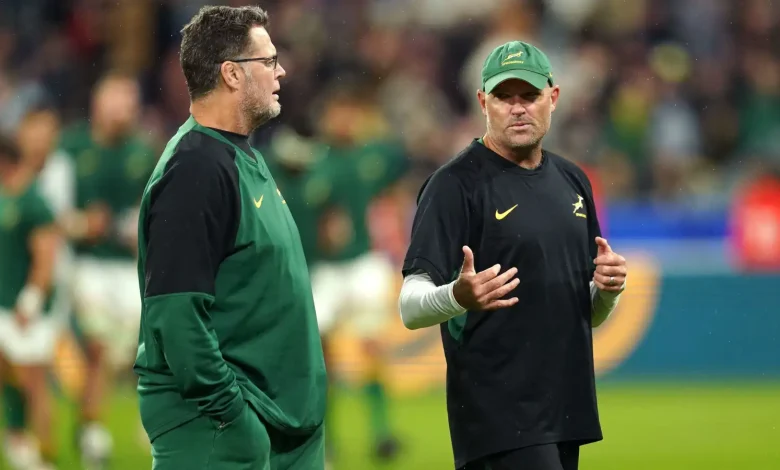‘You cannot simply tackle lower’ – Springboks boss Rassie Erasmus on new tackle laws

SA Rugby director of rugby and Springboks head coach Rassie Erasmus has urged coaches to change players’ behaviour in tackles.
Erasmus has spoken about the topic after South African Rugby Union members approved new laws to make rugby safer at school and club levels at a general council meeting last year.
The new laws mean that tackles in open play must be made at the base of the sternum (breastbone) or below. While they do not apply to the senior professional level, Erasmus said that the Bok coaching staff lowered the tackle-height in training for their players in the build-up to and during the Rugby World Cup.
This led to a lower penalty count for the Springboks, particularly for dangerous or illegal tackles.
No excuse
Erasmus says coaches at clubs and schools who think it will be difficult to implement new tackle height regulations for rugby participation have no justification.
“Coaching and practicing correct technique is necessary to overcome the inability to tackle lower,” Erasmus, who was a key member of the Springboks’ two World Cup winning teams, stated in a statement released by SA Rugby.
As a result, we incorporated it into our technical and fitness regimens for the competition. You can’t just tackle lower without paying attention to the proper form.
“Tackle bags are only training tools and should not dominate your tackle training. You do need to work more on moving bodies, but within a controlled space, where players learn to adjust their height in a more dynamic game-like situation.”
While he believes that technique is crucial, he added that players also need to be conditional correctly and that similar changes will be made across the board.
“Fitness becomes a critical requirement to continue tackling lower over the course of a match, so appropriate fitness and conditioning is critical,” he said.
“Upright ball-and-all tackles are not practical under these laws, so you need to adapt the way you coach the tackle. Wrap tackles bring players more upright into contact, which shares headspace in a high-risk situation, and increases the risk of head-contact and concussions.
“Whether we like it or not, at some stage the laws are going to change worldwide around tackle-height, so we need to be part of the solution and not having to play catch-up after the laws have already been made.”
Will not detract from the physicality and confrontational nature of rugby
“As custodians of the game, we have an obligation to adhere to the scientific evidence to guarantee that players are well-protected in a physically demanding, contact-based sport like rugby union,” he continued.
“This implies that even if the gladiatorial aspect of the game is appreciated, the players shouldn’t be at undue risk. The current revisions to the law aim to reduce the danger of catastrophic head, neck, and spinal injuries, long-term brain health concerns, and concussions while maintaining the athletic character of the game.
“Yes, the new rules will alter certain aspects of the game, such running rugby, open play, and more offloads, but they won’t take away from the intensity and competitive spirit that characterize rugby union.
“There is a change away from the tackler being the only person accountable for the safety of the tackle contest by limiting the ball carrier’s body height and position into contact. This does not, however, prevent the ball carrier from making contact with the ball; the tackler must always have a safe, visible target in which to strike the ball. This ensures the safety of the ball carrier and the tackler during the game.



